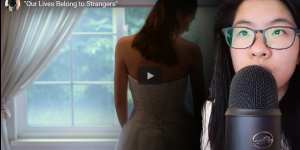In 1919, Fong Mei immigrated to Vancouver to become a bride.
When she arrived, she realized the truth. There's more than one way to be imprisoned.
This project was based on the story of Fong Mei from the Disappearing Moon Cafe. This video explores her emotional experience of entrapment and fear that is tied to both her prison cell and her wedding dress.
Narrated by Vanessa Chan
Fong Mei is portrayed by Minori Kato-Hopkins
Directed, Filmed, and Edited by Caitlin Young
It Is What It Isn’t
Among our first ideas, Caitlin, Minori, and I wanted a focus on female stories from SKY Lee’s Disappearing Moon Cafe. We landed on the story of Fong Mei, and the disjointedness of her experiences coming to Canada placed against the grandness of her wedding with Wong Choy Fuk. Overall, the creation of this video was an interesting exercise of visual and bodily experiences not being what they seem to be at first glance—not only in terms of the video’s content, but also in the filming process.
For myself, I was hoping we could capture the feelings of anxiety and claustrophobia that stuck out to me when reading Fong Mei’s description of her own wedding. Alejandro Yoshizawa (Al) helpfully suggested we look at the trappings of the wedding (dress) being comparable to the confines of the immigration office cells. Based on our consultation with Al, I looked specifically for quotes that seemed to apply to both the wedding and the immigration office experiences. Although the point is to blur the lines between the two situations, I think that the video is most impactful when one is familiar with the lines and where they came from. For example, when the shadow of an immigration officer passes by Fong Mei’s cell, the voiceover says “But you see, even at night and in my sleep, I must be on my guard” (Lee 45), which actually refers to her husband, Choy Fuk. Not all the lines are mismatched, but knowing which parts of the monologue are emphasizes an uneasy similarity of supposedly opposing situations.
The disjointedness of how things appear versus what they actually are is a core theme of Our Lives Belong to Strangers, and it is interesting to see it manifest in the film-making process itself. The wedding dress scenes were filmed in a home that would not have existed in 1919, with a white blanket draped over a TV, and in a space normally occupied by a treadmill. The immigration office cell scenes were filmed in the corner of a garbage room, with people coming in and out between takes, and the shadow of the bars were created using a cooling rack held up against a light. Even the character of Fong Mei herself is acted by Minori, but voiced by myself. The decision to include or exclude things that were originally in-frame—such as the treadmill—changes the ways in which the space in the frame is experienced by the character, and by extension, the audience.
An empty space in a garbage room becomes a jail cell, a place of confine, given the illusion of bars, and the elegant and bright wedding scene is marred by the context of a foreign land and bought relationship. Illusions and mismatching occurs when a space is not experienced with a correct understanding or orientation of physical, social, and historical contexts. Our Lives Belong to Strangers plays with this idea as we offer a new context with which to understand Fong Mei's wedding that her sister and many wedding attendees did not seem to see.
Reflection written Oct. 12, 2018.
